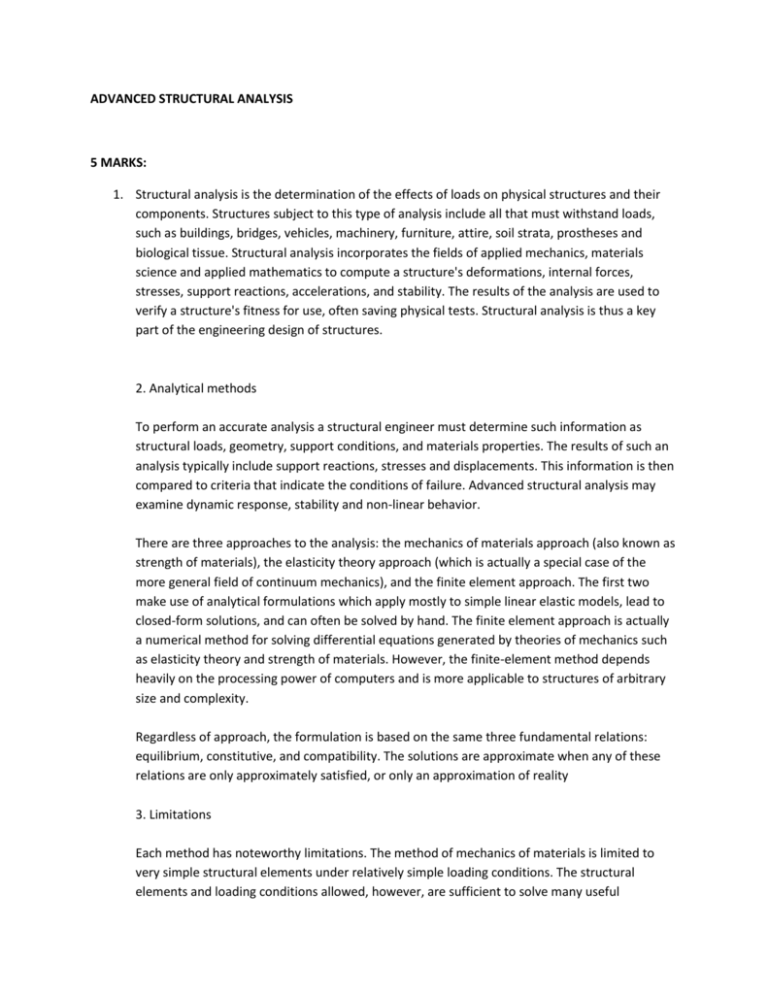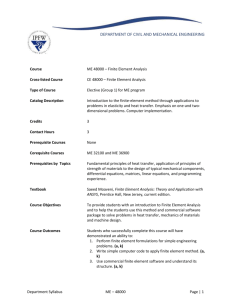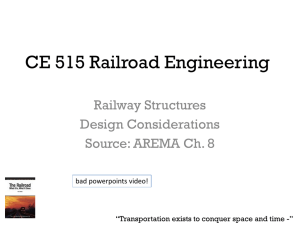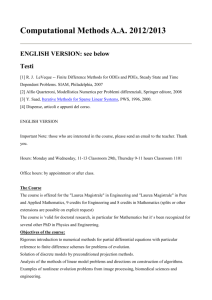advanced structural analysis
advertisement

ADVANCED STRUCTURAL ANALYSIS 5 MARKS: 1. Structural analysis is the determination of the effects of loads on physical structures and their components. Structures subject to this type of analysis include all that must withstand loads, such as buildings, bridges, vehicles, machinery, furniture, attire, soil strata, prostheses and biological tissue. Structural analysis incorporates the fields of applied mechanics, materials science and applied mathematics to compute a structure's deformations, internal forces, stresses, support reactions, accelerations, and stability. The results of the analysis are used to verify a structure's fitness for use, often saving physical tests. Structural analysis is thus a key part of the engineering design of structures. 2. Analytical methods To perform an accurate analysis a structural engineer must determine such information as structural loads, geometry, support conditions, and materials properties. The results of such an analysis typically include support reactions, stresses and displacements. This information is then compared to criteria that indicate the conditions of failure. Advanced structural analysis may examine dynamic response, stability and non-linear behavior. There are three approaches to the analysis: the mechanics of materials approach (also known as strength of materials), the elasticity theory approach (which is actually a special case of the more general field of continuum mechanics), and the finite element approach. The first two make use of analytical formulations which apply mostly to simple linear elastic models, lead to closed-form solutions, and can often be solved by hand. The finite element approach is actually a numerical method for solving differential equations generated by theories of mechanics such as elasticity theory and strength of materials. However, the finite-element method depends heavily on the processing power of computers and is more applicable to structures of arbitrary size and complexity. Regardless of approach, the formulation is based on the same three fundamental relations: equilibrium, constitutive, and compatibility. The solutions are approximate when any of these relations are only approximately satisfied, or only an approximation of reality 3. Limitations Each method has noteworthy limitations. The method of mechanics of materials is limited to very simple structural elements under relatively simple loading conditions. The structural elements and loading conditions allowed, however, are sufficient to solve many useful engineering problems. The theory of elasticity allows the solution of structural elements of general geometry under general loading conditions, in principle. Analytical solution, however, is limited to relatively simple cases. The solution of elasticity problems also requires the solution of a system of partial differential equations, which is considerably more mathematically demanding than the solution of mechanics of materials problems, which require at most the solution of an ordinary differential equation. The finite element method is perhaps the most restrictive and most useful at the same time. This method itself relies upon other structural theories (such as the other two discussed here) for equations to solve. It does, however, make it generally possible to solve these equations, even with highly complex geometry and loading conditions, with the restriction that there is always some numerical error. Effective and reliable use of this method requires a solid understanding of its limitations. 20 marks: 1. Methods using numerical approximation It is common practice to use approximate solutions of differential equations as the basis for structural analysis. This is usually done using numerical approximation techniques. The most commonly used numerical approximation in structural analysis is the Finite Element Method. The finite element method approximates a structure as an assembly of elements or components with various forms of connection between them. Thus, a continuous system such as a plate or shell is modeled as a discrete system with a finite number of elements interconnected at finite number of nodes. The behaviour of individual elements is characterised by the element's stiffness or flexibility relation, which altogether leads to the system's stiffness or flexibility relation. To establish the element's stiffness or flexibility relation, we can use the mechanics of materials approach for simple one-dimensional bar elements, and the elasticity approach for more complex two- and three-dimensional elements. The analytical and computational development are best effected throughout by means of matrix algebra, solving partial differential equations. Early applications of matrix methods were for articulated frameworks with truss, beam and column elements; later and more advanced matrix methods, referred to as "finite element analysis," model an entire structure with one-, two-, and three-dimensional elements and can be used for articulated systems together with continuous systems such as a pressure vessel, plates, shells, and three-dimensional solids. Commercial computer software for structural analysis typically uses matrix finite-element analysis, which can be further classified into two main approaches: the displacement or stiffness method and the force or flexibility method. The stiffness method is the most popular by far thanks to its ease of implementation as well as of formulation for advanced applications. The finite-element technology is now sophisticated enough to handle just about any system as long as sufficient computing power is available. Its applicability includes, but is not limited to, linear and non-linear analysis, solid and fluid interactions, materials that are isotropic, orthotropic, or anisotropic, and external effects that are static, dynamic, and environmental factors. This, however, does not imply that the computed solution will automatically be reliable because much depends on the model and the reliability of the data input. 2. Limitations Each method has noteworthy limitations. The method of mechanics of materials is limited to very simple structural elements under relatively simple loading conditions. The structural elements and loading conditions allowed, however, are sufficient to solve many useful engineering problems. The theory of elasticity allows the solution of structural elements of general geometry under general loading conditions, in principle. Analytical solution, however, is limited to relatively simple cases. The solution of elasticity problems also requires the solution of a system of partial differential equations, which is considerably more mathematically demanding than the solution of mechanics of materials problems, which require at most the solution of an ordinary differential equation. The finite element method is perhaps the most restrictive and most useful at the same time. This method itself relies upon other structural theories (such as the other two discussed here) for equations to solve. It does, however, make it generally possible to solve these equations, even with highly complex geometry and loading conditions, with the restriction that there is always some numerical error. Effective and reliable use of this method requires a solid understanding of its limitations. [edit] Strength of materials methods (classical methods) The simplest of the three methods here discussed, the mechanics of materials method is available for simple structural members subject to specific loadings such as axially loaded bars, prismatic beams in a state of pure bending, and circular shafts subject to torsion. The solutions can under certain conditions be superimposed using the superposition principle to analyze a member undergoing combined loading. Solutions for special cases exist for common structures such as thin-walled pressure vessels. For the analysis of entire systems, this approach can be used in conjunction with statics, giving rise to the method of sections and method of joints for truss analysis, moment distribution method for small rigid frames, and portal frame and cantilever method for large rigid frames. Except for moment distribution, which came into use in the 1930s, these methods were developed in their current forms in the second half of the nineteenth century. They are still used for small structures and for preliminary design of large structures. The solutions are based on linear isotropic infinitesimal elasticity and Euler–Bernoulli beam theory. In other words, they contain the assumptions (among others) that the materials in question are elastic, that stress is related linearly to strain, that the material (but not the structure) behaves identically regardless of direction of the applied load, that all deformations are small, and that beams are long relative to their depth. As with any simplifying assumption in engineering, the more the model strays from reality, the less useful (and more dangerous) the result. 3. Structures and Loads A structure refers to a body or system of connected parts used to support a load. Important examples related to Civil Engineering include buildings, bridges, and towers; and in other branches of engineering, ship and aircraft frames, tanks, pressure vessels, mechanical systems, and electrical supporting structures are important. In order to design a structure, one must serve a specified function for public use, the engineer must account for its safety, aesthetics, and serviceability, while taking into consideration economic and environmental constraints. Other branches of engineering work on a wide variety of nonbuilding structures. [edit] Classification of structures It is important for a structural engineer to recognize the various types of elements composing a structure and to be able to classify structures as to their form and function. Some of the structural elements are tie rods, rod, bar, angle, channel, beams, and columns. Combination of structural elements and the materials from which they are composed is referred to as a structural system. Each system is constructed of one or more basic types of structures such as trusses, cables and arches, frames, and surface structures. [edit] Loads Main article: Structural load Once the dimensional requirement for a structure have been defined, it becomes necessary to determine the loads the structure must support. In order to design a structure, it is therefore necessary to first specify the loads that act on it. The design loading for a structure is often specified in building codes. There are two types of codes: general building codes and design codes, engineer must satisfy all the codes requirements for a reliable structure. There are two types of loads that structure engineering must encounter in the design. First type of load is called Dead loads that consist of the weights of the various structural members and the weights of any objects that are permanently attached to the structure. For example, columns, beams, girders, the floor slab, roofing, walls, windows, plumbing, electrical fixtures, and other miscellaneous attachments. Second type of load is Live Loads which vary in their magnitude and location. There are many different types of live loads like building loads, highway bridge Loads, railroad bridge Loads, impact loads, wind loads, snow loads, earthquake loads, and other natural loads. [edit] Analytical methods To perform an accurate analysis a structural engineer must determine such information as structural loads, geometry, support conditions, and materials properties. The results of such an analysis typically include support reactions, stresses and displacements. This information is then compared to criteria that indicate the conditions of failure. Advanced structural analysis may examine dynamic response, stability and non-linear behavior. There are three approaches to the analysis: the mechanics of materials approach (also known as strength of materials), the elasticity theory approach (which is actually a special case of the more general field of continuum mechanics), and the finite element approach. The first two make use of analytical formulations which apply mostly to simple linear elastic models, lead to closed-form solutions, and can often be solved by hand. The finite element approach is actually a numerical method for solving differential equations generated by theories of mechanics such as elasticity theory and strength of materials. However, the finite-element method depends heavily on the processing power of computers and is more applicable to structures of arbitrary size and complexity. Regardless of approach, the formulation is based on the same three fundamental relations: equilibrium, constitutive, and compatibility. The solutions are approximate when any of these relations are only approximately satisfied, or only an approximation of reality. 4. Service in Informatics and Analysis (SIA Ltd.) was one of the pioneering time-sharing service bureau companies in the late 1960s, later known as SIA Computer Services. Its head office was located at Lower Belgrave Street, close to Victoria Station in London, and the company had branch offices in Edinburgh, Manchester, the West End, Paris and (much later) in Hong Kong. SIA offered terminal services via the Post Office telephone network at speeds of 10, 15, 30, 60 and 120 characters per second for Teletype-style terminals and of 1200 baud, 2400 baud and 4800 baud for Remote Job Entry terminals. Later with the release of the IBM PC, systems were developed to emulate the Remote Batch and interactive terminals. Clients could also visit the head or branch offices to submit their jobs personally or have them accepted and supervised by the production department. In 1968 the company installed a Control Data Corporation CDC 6600 mainframe computer – the first CDC 6600 installed in the United Kingdom.[1] It was generally considered to be the first successful supercomputer, outperforming its fastest predecessor, IBM 7030 Stretch, by about three times. It remained the world's fastest computer from 1964 to 1969, when it relinquished that status to its successor, the CDC 7600. By 1974 SIA added more processing power by installing a Control Data Cyber-72 at Victoria. SIA had assembled a comprehensive library of proven software packages drawn from all over the world. They covered a range of disciplines: electronics, management science, integrated survey and statistical, integrated cluster analysis, segmentation analysis, simulation, financial planning, production planning and control systems, civil and structural engineering, finite element stress analysis, box girder bridge design, highway engineering, business systems, business data processing, database management and many others. Client support groups SIA's client support groups included: Technical services Supported clients writing and running their own programs, whether written in ALGOL, BASIC, COBOL, or Fortran. They provided training in all user aspects of the Kronos-75 service and on operating various types of terminal. Commercial team Supported the SIA sales accounting package and the database management system SYSTEM 2000. They also developed computer systems to meet various business applications to meet the individual needs of client organisations. Applications covered included invoicing, sales ledger, sales analysis, stock control, bill of material processing, library information retrieval and a wide range of database implementations characterised by the need to store quantities of data and to retrieve from it in a number of differing ways. Management sciences team Supported the statistics, linear programming, depot location and financial modelling packages offered. Production scheduling, warehouse siting, cash flow modelling and survey analysis are typical applications. Engineering Civil and structural support packages for bridge and building design and detailing, for soil mechanics and for other civil engineering applications. Offshore engineering Concentrated on the business of designing structures for use in offshore oil production. Waveloading, static and dynamic analyses, towing studies and stability problems were also covered. Advanced structural analysis Supported clients tackling problems with the help of finite element techniques and other analyses. Examples are drawn mostly from mechanical engineering — from nuclear power stations through aircraft and satellites to diesel engines. Chemical engineering Assisted process designers to use a powerful flowsheet simulator program, arguably the best in the world. [edit] Highway engineering and mapping Supported and developed a range of programs for use in highway design and in ground modelling and mapping. Programs developed by this team have helped British and foreign consultants to win highway design contracts in the Middle East since the design timescale is dramatically shortened by their use. Transportation Developed and maintained the TFA suite of programs for transportation planning studies and provided consultancy services. Systems The operating systems running on the Control Data 6600, Cyber-72 and later Cyber-175 included SCOPE, Kronos and later NOS. The source code was heavily modified for the business needs of the company by a team of systems programmers. Many of the ground-breaking ideas[peacock term] developed at SIA were incorporated in Control Data's later systems. SIA was a member of J.U.N.K (Joint Users of NOS and Kronos), a user group formed to share ideas and experiences using Control Data's software.[2]







